
The Class D50 is a type of 2-8-2 steam locomotive built by the Japanese Government Railways (JGR), the Japanese National Railways (JNR) and various manufacturers from 1923 to 1931. The class name indicates that the locomotive has four sets of driving wheels (D) and belongs to one of the classes of tender locomotive allocated a number in the series 50 to 99 in the Japan Railways locomotive numbering and classification scheme of 1928.

The Class KF was a 4-8-4 mainline passenger steam locomotive type built in the United Kingdom by the Vulcan Foundry for the railways of China. Between 1935 and 1936, 24 locomotives were built for the Guangzhou–Hankou Railway designated as the 600 series. Following World War II, and the establishment of the People's Republic of China, the Chinese Government assumed control of the railway and re-designated the engines in 1954 as the "ㄎㄈ" class from the first two syllables of "Confederation", and in 1959 as the "KF" class.

The Class C51 (C51形) is a type of 4-6-2 steam locomotive built by Kisha Seizo Mitsubishi and Japanese National Railways (JNR) Hamamatsu Works. The C classification indicates three sets of driving wheels. The C51 introduced 1.75 m diameter driving wheels to Japan. C51s raised the average speed on the Tōkaidō Main Line from 47.3 km/h (29.4 mph) to 55.3 km/h (34.4 mph). In 1930, a C51 hauled the first Tsubame (swallow) express, reducing travel time between Tokyo and Kōbe to 9 hours.

The Central China Railway was a railway company in Japanese-occupied China established after the Second Sino-Japanese War. It was a joint venture between Japan, the Reformed Government of the Republic of China and the Nanjing National Government. Together with the North China Transportation Company, it was responsible for management of China's railways during the Japanese occupation. In reality, it was a Japanese National Policy Company.

The China Railways AM1 class locomotives were a class of 4-4-0 passenger steam locomotives operated by the China Railway, originally built for the South Manchuria Railway (Mantetsu). The "Ame" name came from the American naming system for steam locomotives, under which locomotives with 4-4-0 wheel arrangement were called "American".
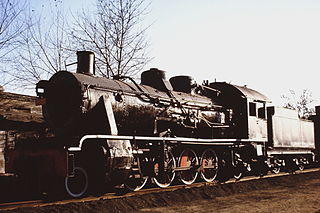
The China Railways JF3 class steam locomotive was a class of 2-8-2 steam locomotives operated by the China Railway, built by the Škoda Works in Czechoslovakia in 1927–1930.
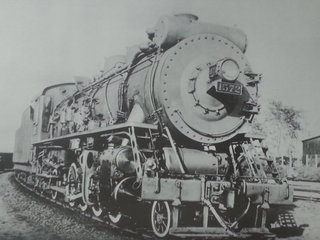
The China Railways JF1 class steam locomotive was a class of 2-8-2 steam locomotives for freight trains operated by the China Railway. They were originally built in the United States, Japan and Manchukuo between 1918 and 1945 for the South Manchuria Railway (Mantetsu), the Manchukuo National Railway, the North China Transportation Company, and the Central China Railway. After the end of the Pacific War, they were taken over by the China Railway, the Korean State Railway in North Korea and by the Korean National Railroad in South Korea, and more were built in China after 1949 for the China Railway, which ultimately operated over 2,000 of the type.
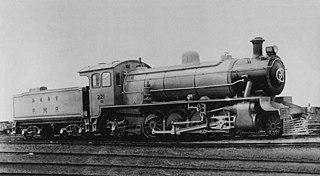
The China Railways JF7 class steam locomotive was a class of 2-8-2 steam locomotives operated by the China Railway, built by the North British Locomotive Company and assembled by the Tangshan Arsenal, as well as American builders between 1913 and 1924.
The China Railways JF12 class steam locomotive was a class of 2-8-2 steam locomotives operated by the China Railway, built by the ALCo in the United States in 1922.
The China Railways JF5 (解放5, Jiěfàng, "liberation") class steam locomotive was a class of 2-8-2 steam locomotives operated by the China Railway, originally built by Kawasaki in Japan in 1923 for the Jichang Railway.
The China Railways JF8 class steam locomotive was a class of 2-8-2 steam locomotives operated by the China Railway, originally built by the Škoda Works in Czechoslovakia in 1935 for the Huainan Railway.
The China Railways JF13 class steam locomotive was a class of 2-8-2 steam locomotives operated by the China Railway, built by the Škoda Works in Czechoslovakia in 1939.
The China Railways JF15 class steam locomotive was a class of 2-8-2 steam locomotives operated by the China Railway, built by the American Locomotive Company in the United States in 1928−1929.
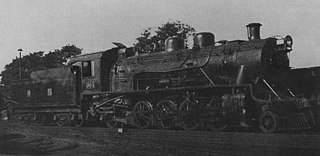
The China Railways JF17 class steam locomotive was a class of 2-8-2 steam locomotives operated by the China Railway, built by Hudswell Clarke in the United Kingdom and by the South Manchuria Railway's Shahekou Works in 1931.
The China Railways JF18 class steam locomotive was a class of 2-8-2 steam locomotives operated by the China Railway, built by the American Locomotive Company in the United States in 1914.
The China Railways JF21 class steam locomotive was a class of 2-8-2 steam locomotives operated by the China Railway, built by the American Locomotive Company in the United States in 1937.
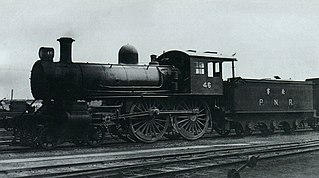
The China Railways AM2 class steam locomotive was a class of 4-4-0 steam locomotives operated by the China Railway, built by the Baldwin Locomotive Works in the United States in 1879.

The Mikasa-class (ミカサ) locomotives were a group of steam tender locomotives of the Chosen Government Railway (Sentetsu) with 2-8-2 wheel arrangement. The "Mika" name came from the American naming system for steam locomotives, under which locomotives with 2-8-2 wheel arrangement were called "Mikado" in honour of the Emperor of Japan, as the first 2-8-2 locomotives in the world were built for Japan.

The Pashishi class (パシシ) locomotives were a group of steam tender locomotives of the Chosen Government Railway (Sentetsu) with 4-6-2 wheel arrangement. The "Pashi" name came from the American naming system for steam locomotives, under which locomotives with 4-6-2 wheel arrangement were called "Pacific".

The Purena-class (プレナ) locomotives were a group of steam tank locomotives with 2-6-2 wheel arrangement of used by the Chosen Government Railway (Sentetsu) in Korea. The "Pure" name came from the American naming system for steam locomotives, under which locomotives with 2-6-2 wheel arrangement were called "Prairie".













